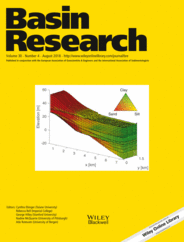
Full text loading...
In this study, we investigate key factors controlling the rift climax to post‐rift marine basin fill. We use two‐ and three‐dimensional seismic data in combination with sedimentological core descriptions from the Hammerfest Basin, south‐western Barents Sea to characterize and analyse the tectonostratigraphy and seismic facies of the Lower Cretaceous succession. Based on our biostratigraphic analyses, the investigated seismic facies are correlated to 5–10 million year duration sequences that make up the stratigraphic framework of the basin fill. The seismic facies suggest the basin fill was deposited in shallow to deep‐marine conditions. During rift climax in Volgian/Berriasian to Barremian times, a fully linked fault array controlled the formation of slope systems consisting of gravity flow deposits along the southern margin of the basin. Renewed uplift of the Loppa High north of the basin provided coarse‐grained sediments for fan deltas and shorelines that developed along the northern basin margin. During the early to middle late Aptian, the input of coarse‐grained sediments occurred mainly in the NW and SW corners of the basin, reflecting renewed uplift‐induced topography in the western flank of the Loppa High and along the western Finnmark Platform. The lower Albian part of the basin fill is interpreted as a post‐rift succession, where the remnant topography associated with the Finnmark Platform continued to provide sediments to prograding fan deltas and adjacent shorelines. During the Albian, a series of faults were reactivated in the northern part of the basin, and footwall wedges comprising various gravity flow deposits occur along these faults. During the latest Albian to Cenomanian, the south‐eastern part of the Loppa High was flooded by a rise in eustatic sea‐level and differential subsidence. However, the western part of the high remained exposed and acted as a sediment source for a shelf‐margin system prograding towards the SE. It is concluded that the rift climax succession is controlled by: along strike variability of throw and steps of the main bounding faults; the diachronous movement of the faults; and the nature of the feeder system. The evolution of the post‐rift succession may be controlled by rifting in adjacent basins which preferentially renew sources of sediments; local reactivation of faults; and local remnant topography of the basin flanks. We suggest that existing tectonostratigraphic models for rift basins should be updated, to incorporate a more regional perspective and integrating variables such as the influence of adjacent rift systems.

Article metrics loading...

Full text loading...
References


Data & Media loading...
Supplements

